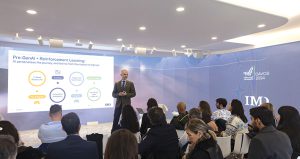DAVOS / WAM
Misiek Piskorski, Professor of Digital Strategy, Analytics and Innovation and Dean of Asia and Oceania at IMD, focused during a session held in the UAE pavilion in Davos, on advanced talent management models. The session, entitled “How to build the leaders for tomorrow”, discussed talent management models using artificial intelligence (AI) to help public and private institutions improve the talent management process.
The session comes in light of the UAE’s increasing interest in attracting and retaining talent in various fields and specialisations in a way that supports the labour market and UAE national economy and raises the country’s competitiveness as one of the leading countries in the region and the world. Piskorski stressed that attracting the right talents is a strategic challenge for companies, adding that talent identification requires strong models of why leaders engage in value-adding behaviours across the domains of leading strategy, execution, stakeholders, people and self. He noted that the best models trace these behaviours to three drivers: know-how, motivation, and situational judgment to engage in the right behaviours at the right time. However, talent management is all about predicting performance in the future in a role which the executive still does not have.
The current assessment tools still need substantial improvement to predict such future performance, and AI can help us with this. Therefore, a great deal of effort in talent management is expended in identifying these elusive high-potential employees to manage their trajectory toward target leadership positions.
In the context of shifting role demands, it is key to develop robust talent pools to ensure the availability of the leadership talent the entity needs in the medium to long term. An inclusive approach that helps individuals own, harness, and amplify their talents to create value for the organisation in new ways is not only a good talent strategy but also drives innovation and fuels dynamic capabilities that can support sustained competitive advantage.
Using robust data from various valid assessment tools continues to be the gold standard and the pathway to optimising prediction. In addition, technology-driven assessment tools such as game-based and AI-enabled adaptive assessment tools provide a wealth of data that can provide new insights into the underlying drivers of performance.
 The Gulf Time Newspaper One of the finest business newspapers in the UAE brought to you by our professional writers and editors.
The Gulf Time Newspaper One of the finest business newspapers in the UAE brought to you by our professional writers and editors.
